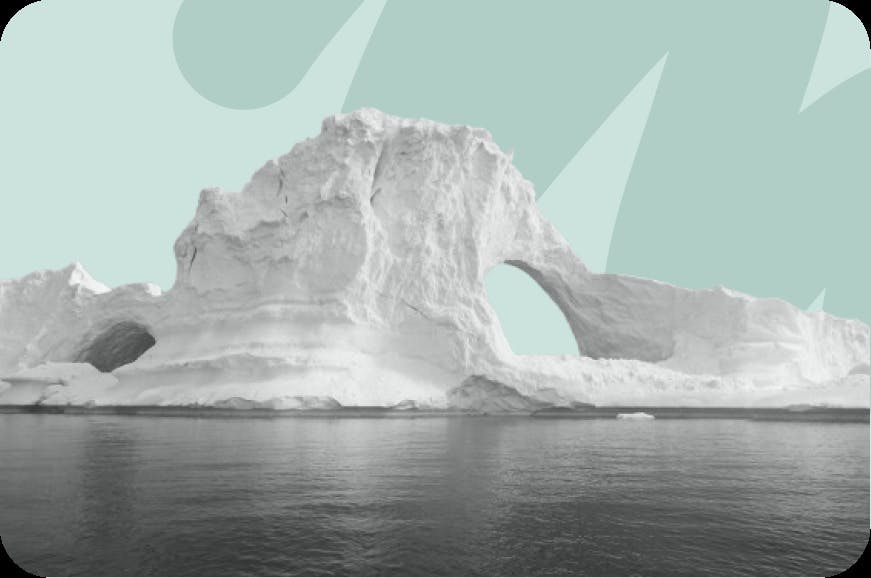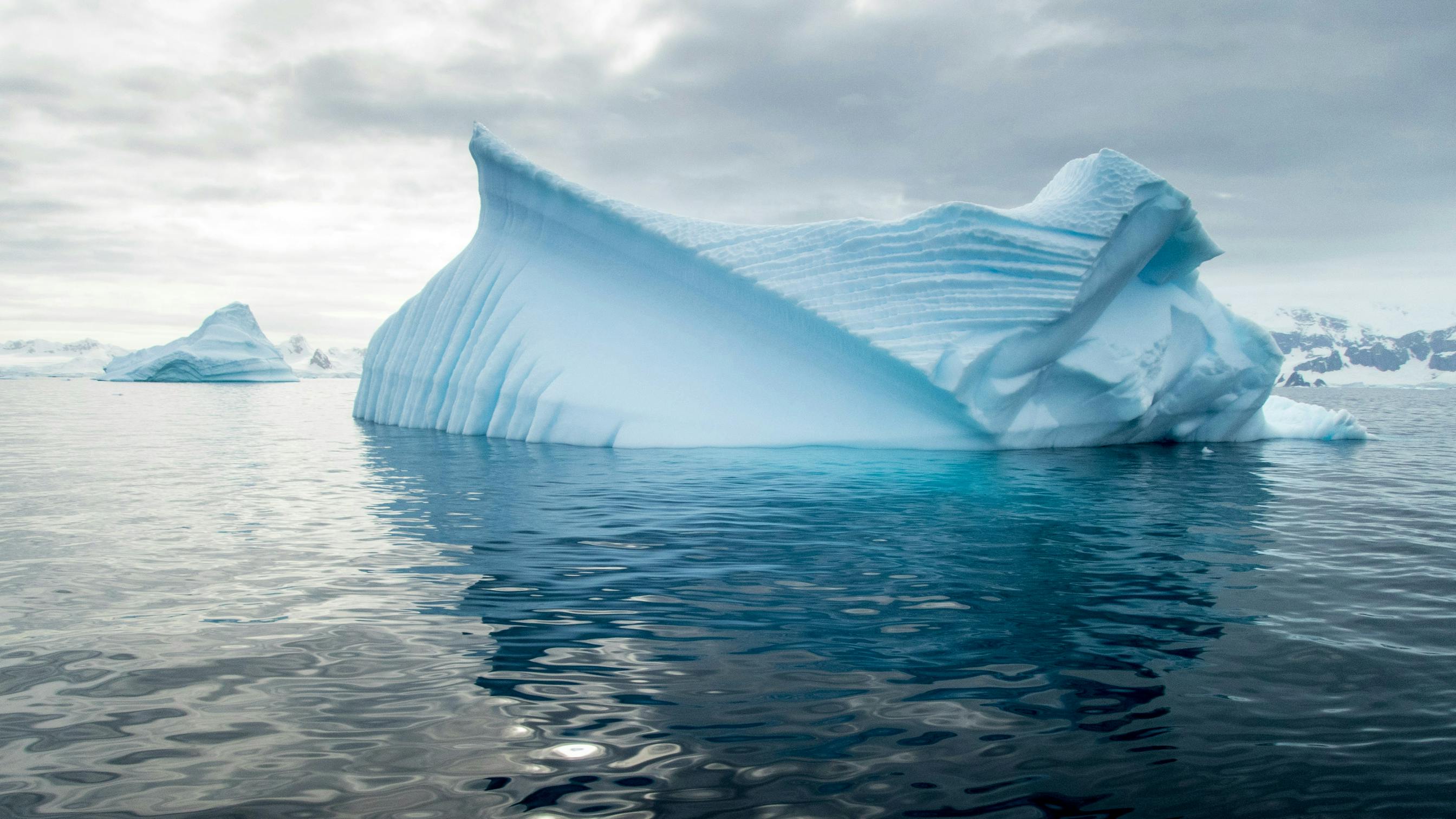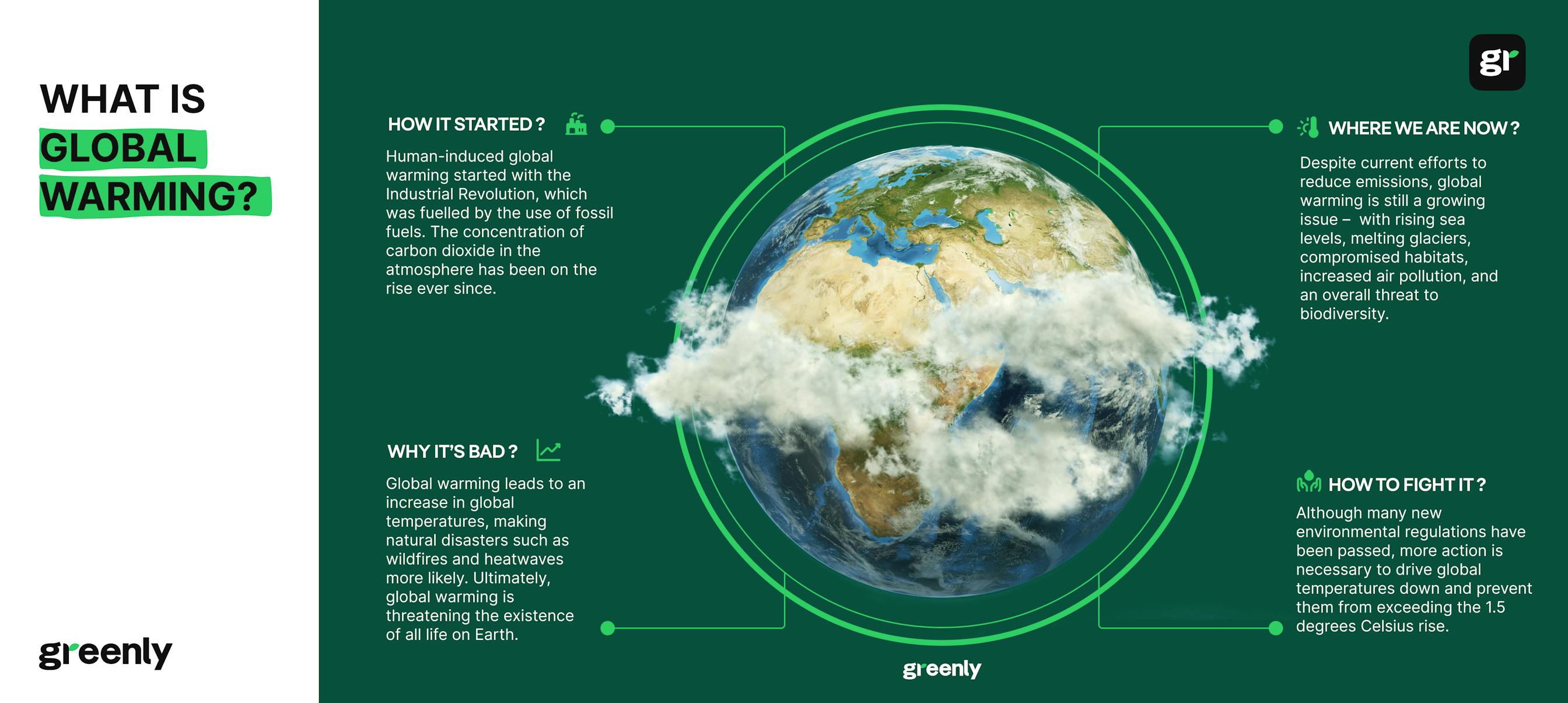ESG / CSR
Industries
Polar Amplification: Why Are the Polar Regions Warming Faster?



The polar regions are warming far faster than anywhere else on Earth. While human activities have steadily increased the planet's average temperature, the poles - especially the Arctic - are heating up nearly four times as quickly. This rapid warming is already having wide-ranging effects, from melting sea ice and glaciers to rising sea levels and more extreme weather patterns around the globe.
👉 In this article, we’ll explore why the polar regions are warming so quickly, breaking down the science of polar amplification and the key factors driving these changes.
Why Are the Polar Regions Important?
The polar regions refer to the two areas of the Earth around the North and South Poles - the Arctic in the north and the Antarctic in the south. These regions are defined by their extremely cold, ice-covered landscapes, and distinct ecosystems. However, despite their similarities, the Arctic and Antarctic have key differences. The Arctic is essentially an ocean surrounded by land, with its sea ice forming and retreating seasonally. In contrast, Antarctica is a vast, ice-covered landmass surrounded by the Southern Ocean.
The polar regions are crucial to the Earth’s climate system. They act like giant refrigerators, helping to regulate global temperatures by reflecting a significant amount of sunlight back into space due to their bright, icy surfaces. This reflective quality, known as albedo, is one of the reasons why these regions have traditionally remained so cold. However, as the climate warms, the ice is shrinking, and the once-stable polar regions are becoming some of the most vulnerable places on Earth.

What is Polar Amplification?
Polar amplification refers to the phenomenon where the polar regions, particularly the Arctic, are warming at a much faster rate than the rest of the planet. While the Earth’s average temperature has risen due to human activities, the Arctic is commonly reported as warming nearly two to three times faster. This accelerated warming has been particularly evident in the past few decades, with some recent studies even suggesting that this rate is under-reported and could be as high as four times faster than the global average.
💡 The 2022 study ‘The Arctic has warmed nearly four times faster than the globe since 1979’, reported in Communications Earth & Environment, provides evidence that the polar regions are warming even faster than commonly reported. The study demonstrates that while many previous reports suggest the Arctic is warming two to three times faster than the global average, this research reveals a nearly fourfold amplification. The discrepancy arises from differences in how Arctic amplification is defined and measured, including variations in the time periods considered and the geographical boundaries used to define the Arctic. This study focuses on the period from 1979 to 2021, leveraging data from several observational datasets, including NASA’s GISTEMP, the Berkeley Earth temperature dataset (BEST), the Met Office HadCRUT5, and ERA5, to offer a more up-to-date and comprehensive analysis of Arctic warming. The inclusion of satellite data from 1979 onwards also provides a clearer picture of recent, more pronounced warming trends.
The concept of polar amplification has been known for over a century, ever since Swedish chemist Svante Arrhenius theorized in 1896 that snow and ice-covered regions would warm more quickly as atmospheric carbon dioxide increased. His early hypothesis was rooted in the idea that, as ice melted, the Earth would reflect less sunlight and absorb more heat. Today, we know that this process is a major factor in polar amplification, but it’s far from the only cause.
While the albedo effect is a major factor, polar amplification is also influenced by other processes, such as changes in cloud cover, heat transport from lower latitudes, and increased moisture in the atmosphere. These combined effects are leading to rapid transformations in the polar regions, which are already showing signs of significant environmental and climatic change.
Key Causes of Polar Amplification
The rapid warming of the polar regions, especially the Arctic, is not caused by a single factor but by a combination of interconnected processes that amplify the warming effect. These processes include:
The Albedo Effect
The albedo effect is the most widely recognized mechanism driving polar amplification. The polar regions are traditionally covered with snow and ice, which reflect a significant portion of incoming sunlight back into space. However, as global temperatures rise, the ice and snow melt, exposing darker surfaces beneath - such as ocean water or bare land. These darker surfaces absorb more solar radiation rather than reflecting it, further warming the region and accelerating the melt. This creates a feedback loop: as more ice melts, more heat is absorbed, leading to even more melting.
This feedback is particularly strong in the Arctic, where sea ice loss is most pronounced. Sea ice in the Arctic has been shrinking by approximately 13% per decade since satellite records began in 1979. As the ice disappears, the Arctic Ocean absorbs more heat, which causes the region to warm at a much faster rate than the global average.
💡Various studies attribute 30% to 60% of Arctic warming to the albedo effect alone!
Atmospheric Convection and Vertical Mixing
Another factor contributing to polar amplification is the difference in atmospheric convection between the tropics and the polar regions. In the tropics, the atmosphere is well-mixed due to constant heating from the sun, which causes warm air to rise and cooler air to sink. This vertical mixing helps distribute heat evenly through the atmosphere. However, in the Arctic, convection is much weaker because the sun's angle is lower, and there is less solar energy reaching the surface.
In the Arctic, the atmosphere is primarily heated from the ground up. The heat trapped near the surface by greenhouse gases has less opportunity to mix vertically, which means the warming remains concentrated close to the Earth's surface. This lack of vertical mixing allows surface temperatures to rise faster than in other regions.
Water Vapour Feedback
Water vapor is another key driver of polar amplification. As global temperatures rise, the atmosphere can hold more moisture, and this effect is especially pronounced in the Arctic, where increased evaporation from warming oceans adds more water vapor to the air. Water vapor acts as a greenhouse gas, trapping even more heat in the atmosphere and further amplifying warming.
As warm, moist air moves from the tropics toward the poles, it cools and condenses, releasing heat into the atmosphere, further intensifying the warming. This process is also responsible for increased cloud cover in the polar regions, which traps more heat and contributes to the ongoing cycle of warming.
Ocean Circulation and Heat Transport
Beyond atmospheric and ice-related mechanisms, ocean circulation plays a critical role in polar amplification, especially in the Arctic. Ocean currents, such as the Atlantic Meridional Overturning Circulation (AMOC), transport warm water from the tropics toward the poles. This heat transfer is essential for moderating global climate, but disruptions to these currents can have profound effects on the polar regions.
In recent decades, the AMOC has weakened due to increased freshwater input from melting glaciers and sea ice, particularly from Greenland. This influx of freshwater dilutes the salty ocean water, making it less dense and disrupting the sinking process that drives the deep-water circulation of the AMOC. A key component of this system is the Gulf Stream, which transports warm water from the tropics to the Arctic. As the AMOC weakens, this warm water continues to flow northward, but the return of cold water to the tropics is reduced. As a result, the Arctic retains more heat from the warmer tropical waters, accelerating the warming trend and exacerbating sea ice melt.
Shifting Weather Patterns and Atmospheric Conditions
The fast-changing polar environment also affects atmospheric circulation, particularly through its impact on the polar jet stream. The polar jet stream is a fast-flowing current of air high in the atmosphere that acts as a boundary between cold polar air and warmer air to the south. As the Arctic warms, the temperature gradient between the polar regions and lower latitudes weakens, causing the jet stream to slow down and meander.
These changes in the jet stream lead to more frequent atmospheric blocking patterns, where warm air becomes trapped over the Arctic for extended periods. This not only exacerbates warming in the region but also triggers extreme weather events in mid-latitudes, such as cold spells, heatwaves, and unusual storm patterns. Some studies have linked these jet stream changes to severe weather events across North America and Europe, illustrating the far-reaching consequences of Arctic amplification.
Moreover, with weaker atmospheric circulation, cloud cover has increased in the polar regions, especially during the summer months. These clouds trap additional heat, further boosting
Arctic vs. Antarctic: Why Polar Amplification is More Extreme in the North
While polar amplification occurs in both the Arctic and Antarctic, the phenomenon is far more pronounced in the Arctic. This is largely due to geographical differences, the varying influence of ocean currents, and the extent of ice loss in each region. In the Arctic, the combination of sea ice decline, atmospheric convection, and heat transport from lower latitudes significantly accelerates warming, making it one of the fastest-warming areas on Earth. The following table outlines the key differences between the Arctic and the Antarctic, highlighting why the Arctic is experiencing a more dramatic rate of polar amplification:
| Factor | Arctic | Antarctic |
|---|---|---|
| Geography | Ocean surrounded by land, leading to more sea ice melt and exposure to warming water. | Landmass surrounded by ocean, which acts as a buffer against rapid temperature changes. |
| Ice-Albedo Feedback | Strong feedback due to rapid sea ice loss, leading to faster warming as darker ocean water absorbs more heat. | Less pronounced feedback because of the vast ice sheets covering the land, which reflect sunlight more consistently. |
| Ocean Circulation | More warm water flows into the Arctic from the tropics via the Gulf Stream, accelerating warming. | The surrounding Southern Ocean circulates cold water, helping to moderate temperature increases. |
| Atmospheric Convection | Limited convection traps heat near the surface, intensifying warming. | Higher elevation and greater convection help reduce warming near the surface. |
| Climate Sensitivity | Greater sensitivity to global temperature changes, leading to rapid warming. | Lower sensitivity, resulting in slower warming compared to the Arctic. |
The Impact of Climate Change on Heating Polar Regions
Polar amplification is closely tied to the broader issue of global climate change. Over the past century, human activities - especially the burning of fossil fuels - have significantly increased greenhouse gases (GHGs) like carbon dioxide (CO2) and methane (CH4) in the atmosphere. These gases trap heat, leading to a rise in global temperatures. Since the Industrial Revolution, CO2 levels have surged from 275 parts per million (ppm) to over 415 ppm, driving global warming.
As global temperatures rise, the polar regions - particularly the Arctic - experience these effects more dramatically than other parts of the world. As we’ve discussed, this disproportionate warming is due to several interconnected processes that are uniquely sensitive to climate change. Rising global temperatures intensify the albedo effect as sea ice melts, reduce vertical mixing in the atmosphere, and increase water vapor, all of which fuel polar amplification. In essence, the same forces driving global climate change - greenhouse gas emissions and warming - are directly responsible for triggering and accelerating the mechanisms that cause the polar regions to heat faster than the rest of the planet.


The Impacts of Polar Amplification
The rapid warming of the polar regions is not just an isolated phenomenon - it has far-reaching consequences that affect global weather patterns, sea levels, ecosystems, and human populations. The most severe impacts include:
Rising Sea Levels
One of the most significant consequences of polar amplification is the accelerated melting of ice sheets and glaciers, particularly in the Arctic and parts of Antarctica. As the ice melts, it contributes to global sea-level rise. The Greenland ice sheet alone has been losing around 270 billion metric tons of ice per year, a pace that continues to increase. If polar ice continues to melt at current rates, scientists predict sea levels could rise by over a meter by 2100, threatening coastal communities worldwide.
Extreme Weather Patterns
Polar amplification is also linked to changes in weather patterns far beyond the polar regions. As the Arctic warms, it disrupts the jet stream - a fast-moving band of air that controls weather patterns in the Northern Hemisphere. A weakened jet stream can cause weather systems to stall, leading to prolonged periods of extreme weather, such as heatwaves, cold spells, and heavy rainfall. For example, the "polar vortex" phenomenon, where cold Arctic air moves southward, has been increasingly linked to polar warming, leading to extreme winter events in regions like North America and Europe.
Ecosystem Disruptions
Polar ecosystems are incredibly vulnerable to the effects of rapid warming. In the Arctic, the loss of sea ice is threatening the habitats of iconic species like polar bears, seals, and walruses, all of which rely on ice for hunting and breeding. Similarly, warming temperatures are affecting migratory patterns, food availability, and the overall balance of the Arctic food chain. In the Antarctic, penguin populations are also at risk due to shifting ice conditions and warming waters. These ecosystem disruptions not only threaten biodiversity but also impact indigenous communities that depend on these species for their livelihoods.
Feedback Loops and Tipping Points
The consequences of polar amplification are compounded by the existence of dangerous feedback loops and climate tipping points. As ice melts and permafrost thaws, large amounts of methane - a potent greenhouse gas - are released into the atmosphere, further accelerating global warming. Additionally, the loss of reflective ice surfaces leads to increased absorption of solar radiation, amplifying the warming effect. These feedback mechanisms could potentially push the Earth's climate system past critical thresholds, triggering irreversible changes in the global climate.
The Human Toll of Warming Polar Regions
The consequences of polar amplification are not confined to environmental changes alone - they also pose serious challenges for human populations, especially for communities living in or near the polar regions. However, even people far from the Arctic and Antarctic are beginning to experience the ripple effects of these changes in their daily lives.
Threats to Indigenous Communities
Indigenous peoples living in the Arctic regions, such as the Inuit, Sámi, and Yupik, have long relied on the stability of the ice and the ecosystems it supports. As the ice disappears and the seasons become more unpredictable, traditional ways of life are under threat. Hunting, fishing, and herding, which are critical sources of food and income for many Arctic communities, are becoming increasingly difficult. In some regions, thawing permafrost is causing damage to infrastructure like roads, buildings, and pipelines, leading to costly repairs and the displacement of communities.
Moreover, the loss of cultural traditions closely tied to the land and sea ice is having a profound impact on indigenous identities. As environments change, there is a growing need for adaptive strategies, but the rapid pace of transformation makes it challenging for these communities to cope. Many are being forced to migrate, leading to "climate refugees".
Global Economic Impact
Beyond the polar regions, the economic implications of polar amplification are becoming more evident. As sea levels rise, coastal cities around the world face increasing threats of flooding, storm surges, and erosion. These challenges are already leading to significant costs for infrastructure damage, insurance claims, and disaster recovery efforts.
Polar amplification also affects industries such as shipping, fishing, and energy. As Arctic sea ice retreats, new shipping routes are opening up, potentially reducing the travel time for cargo between Europe and Asia. However, this also raises concerns about environmental degradation and geopolitical tensions as nations vie for control over newly accessible resources. Additionally, the disruption of fish populations due to warming waters and shifting ecosystems could severely affect global fisheries, impacting food security and trade.
Health Impacts
Climate change and polar amplification are beginning to have direct effects on human health. The increased frequency of extreme weather events, such as heatwaves and cold spells, is already leading to more heat-related illnesses, respiratory issues, and even deaths in affected areas. In the Arctic, the thawing of permafrost has the potential to release ancient pathogens that have been trapped in the frozen soil for millennia, raising concerns about emerging diseases. Moreover, the disruption of local food sources could lead to food insecurity and malnutrition, particularly among indigenous populations.
Polar amplification also contributes to the spread of diseases carried by insects, as warming temperatures allow these vectors to thrive in previously inhospitable regions. Diseases like Lyme disease and West Nile virus, once confined to warmer climates, are now spreading further north, posing new challenges for public health systems.
Solutions and Adaptive Strategies
Addressing the rapid warming in the polar regions requires a multifaceted approach that combines mitigation efforts to reduce the root causes of global warming with adaptation strategies to manage its impacts.
Mitigation: Reducing Greenhouse Gas Emissions
Mitigation remains the most critical factor in slowing the warming of the polar regions. Reducing greenhouse gas emissions, especially from burning fossil fuels, is essential to limit further temperature increases and prevent catastrophic impacts. International agreements like the Paris Agreement aim to unite countries in efforts to limit global warming to well below 2°C above pre-industrial levels. Meeting these goals would significantly reduce the severity of polar amplification and its consequences.
Key mitigation strategies include:
- Transitioning to renewable energy sources: Shifting away from fossil fuels and embracing solar, wind, and hydropower can drastically cut emissions.
- Enhancing energy efficiency: Reducing energy consumption through more efficient buildings, transportation systems, and industrial processes can lower emissions while saving costs.
- Protecting and restoring ecosystems: Forests, wetlands, and other ecosystems act as natural carbon sinks, absorbing CO2 from the atmosphere. Expanding reforestation efforts, protecting critical habitats, and restoring degraded ecosystems can help offset emissions while enhancing biodiversity.
- Carbon capture technologies: New technologies like carbon capture, utilization, and storage (CCUS) aim to trap CO2 before it enters the atmosphere or remove it from the air. While still in the early stages of development, these technologies could play a significant role in reducing atmospheric greenhouse gases.
By curbing emissions, we can slow the rate of global warming and, by extension, reduce the intensity of polar amplification. However, given the current trajectory of climate change, adaptation strategies are also urgently needed.
Adaptation: Building Resilience to Polar Warming
While mitigation is essential, the impacts of climate change are already being felt, particularly in the polar regions and further warming is inevitable, even if we were to eliminate all GHG emissions today. This is why adaptation strategies are crucial for helping communities and ecosystems adjust to the changes that are now unavoidable.
Key adaptation strategies include:
- Relocating vulnerable communities: As sea levels rise and permafrost thaws, some Arctic communities may need to relocate to safer areas. This requires not only physical infrastructure but also policies that respect the rights and cultural heritage of indigenous peoples.
- Strengthening infrastructure: Building more resilient infrastructure that can withstand the changing climate is vital. This includes reinforcing coastal defenses, developing more durable buildings in areas with melting permafrost, and upgrading transportation systems to handle the new environmental conditions.
- Sustainable Arctic development: As the Arctic opens up to new economic activities such as shipping and resource extraction, these industries must be managed in ways that minimize environmental damage. International cooperation is essential to ensure that Arctic development occurs sustainably and equitably.
- Investing in early warning systems: Monitoring and predicting climate change-related events, such as extreme weather, is critical for reducing their impacts. Early warning systems can help governments and communities prepare for storms, floods, or heatwaves, saving lives and reducing economic damage.
International Cooperation and Policy Implementation
The unique nature of the polar regions, particularly the Arctic, means that international cooperation is essential for effective action. The Arctic is governed by multiple nations, and any long-term solution to the challenges of polar amplification must involve collaboration between these countries.
Organizations such as the Arctic Council play a vital role in fostering cooperation between Arctic states and Indigenous peoples. By promoting sustainable development and environmental protection, the Council helps guide the region's response to the growing pressures of climate change. Similarly, global climate initiatives like the United Nations Framework Convention on Climate Change (UNFCCC) provide platforms for nations to negotiate and implement climate action plans.
Effective climate policy should also focus on:
- Funding and investment in climate resilience: Developing countries, particularly those in the Arctic, need financial support to implement adaptation measures. International funds, such as the Green Climate Fund, provide critical resources to help vulnerable nations cope with the impacts of climate change.
- Strengthening climate agreements: Ongoing international negotiations must prioritize more ambitious emission reduction targets. The Paris Agreement set a foundation, but future climate talks must focus on enforcing commitments and increasing efforts to limit global temperature rise.
By combining mitigation, adaptation, and cooperation, there is hope that the impacts of polar amplification can be managed and mitigated.
How Greenly Can Help Your Company Become Part of the Solution
As polar amplification accelerates the impacts of climate change, businesses play a crucial role in taking action. Greenly is here to support your company’s journey toward sustainability, offering a range of carbon management and sustainability solutions tailored to your needs. By working with Greenly, your business can become part of the solution, actively reducing its environmental impact and contributing to global efforts to mitigate climate change.
Carbon Management
At Greenly, our cutting-edge platform helps you to manage your business’s carbon footprint. Here’s how we can help:
- Measure Your GHG Emissions: Gain full visibility into your company’s Scope 1, 2, and 3 emissions. Our advanced technology delivers effective tracking and reporting, offering you the data needed to understand and reduce your carbon footprint.
- Tailored Emissions Reduction Plans: Work with our team of climate experts to develop a customized strategy that targets your highest emission areas. We help you implement practical, high-impact actions to significantly lower your environmental footprint.
- Monitor and Report on Progress: Our user-friendly platform provides continuous tracking of your progress toward net-zero goals. Stay on top of your emissions reductions and ensure that your sustainability strategies are delivering the desired outcomes.
Supply Chain Decarbonisation
Reducing emissions across your supply chain is essential for hitting your sustainability targets. Greenly helps you tackle Scope 3 emissions with solutions designed to enhance supply chain transparency, engage suppliers, and transition to low-carbon alternatives. By partnering with us, you’ll ensure that sustainability extends beyond your company and into every aspect of your business operations.
Seamless Integration for Easy Carbon Management
Greenly’s platform is designed for ease of use, allowing you to track, measure, and manage your environmental impact without complications. From monitoring progress against ESG goals to integrating sustainability into your daily operations, our platform makes carbon management less of a headache.
Why Choose Greenly?
Partnering with Greenly means more than just reducing your carbon footprint - it’s about positioning your business as a sustainability leader. We offer:
- End-to-End Support: From carbon measurement to implementation of reduction strategies, we guide you through every step of your sustainability journey.
- Expert Guidance: Benefit from working with experienced climate professionals who provide insights and recommendations tailored to your industry and business model.
- Cutting-Edge Technology: Our platform ensures you have the tools to track emissions, manage sustainability data, and measure progress with accuracy and ease.
Start your sustainability journey with Greenly and make a lasting impact on the fight against climate change. Together, we can help your business reduce emissions, achieve its net-zero goals, and contribute to a cooler, more sustainable planet for future generations.






